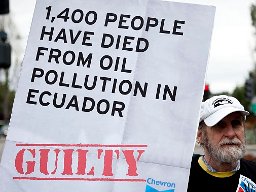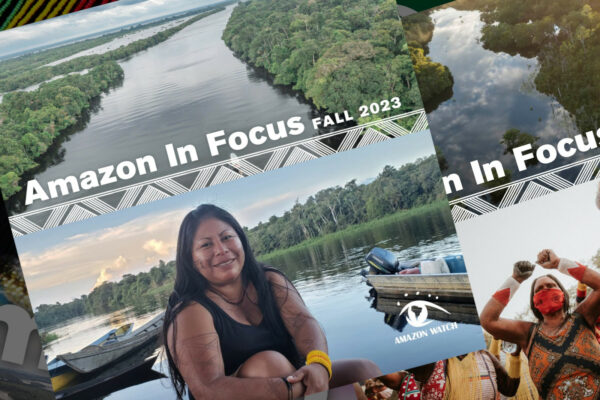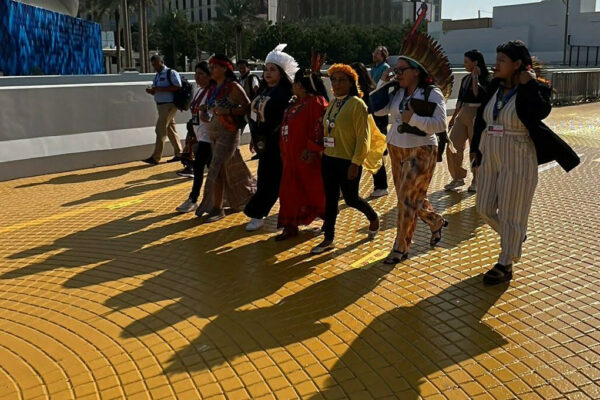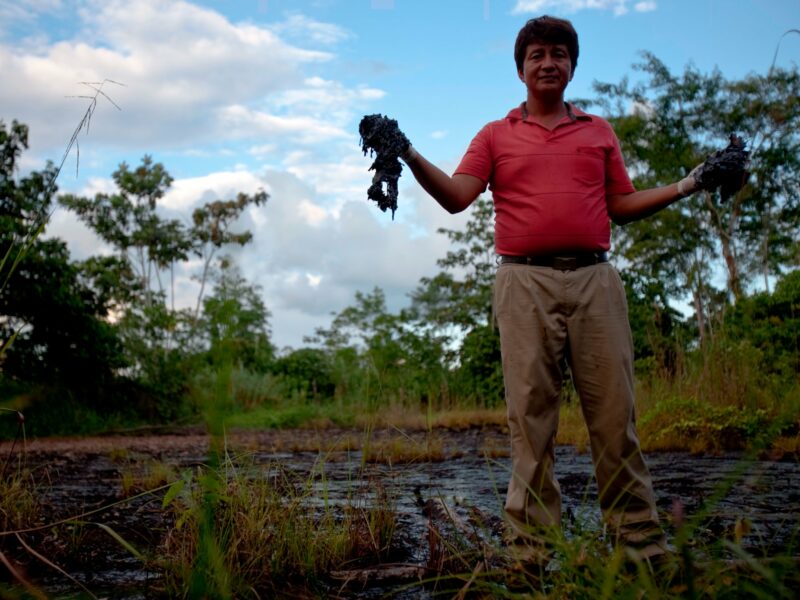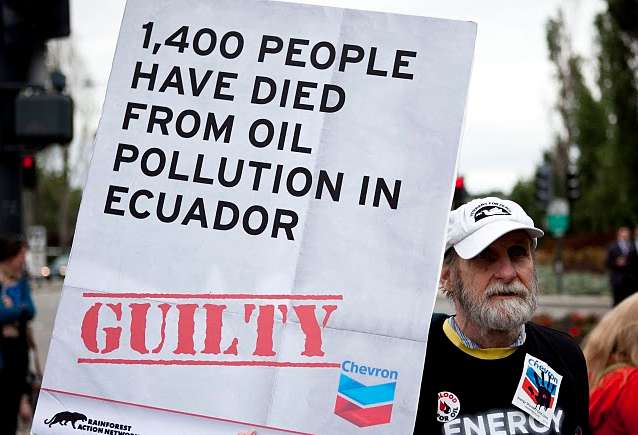
Last week, I attended a roundtable discussion with community members from the Oriente region of the Ecuadorian Amazon who are part of a historic lawsuit to force Chevron to clean up the devastation that oil development caused in their region. Because of the damage to the region, farmers cannot grow crops, the poor get poorer, and local communities are left to deal with cancers, learning disabilities, and other health effects.
Now, local leaders representing the 30,000 people affected by the oil company’s destruction are traveling to San Ramon, California, to protest Chevron’s annual shareholder meeting today. There, they will deliver a letter signed by community leaders (and maybe you) calling on Chevron to clean up their homeland.
You can read the letter here in English – in this video it is read in Spanish.
What makes their lawsuit against Chevron extraordinary, however, is that they won. In February, 17 years after the case was first filed, a judge in Ecuador ordered Chevron to pay $8.6 billion in damages, and that number doubled when the company refused to apologize. For reference, BP agreed to pay $20 billion after the disaster in the Gulf of Mexico.
Of course, Chevron isn’t giving up. Texaco, the company behind the devastation, originally argued to have the trial relocated from New York City to Ecuador, where they believed they could get a more favorable decision. In 2001, Chevron was so confident in Texaco’s ability to win, that the oil giant merged with Texaco and assumed Texaco’s liabilities.
Now, Chevron is attempting to use the US courts to block the ruling, even though it was Chevron that agreed to abide by the Ecuadorian court’s decision when the trial was moved out of the U.S. in 2002.
But it isn’t just the lawsuit that is historic. Humberto Piaguaje, a leader from the Secoya tribe, told us that when the oil company arrived in the 1960s, there were six tribes in the region, but one has since disappeared entirely. The remaining tribes, including his own, are still facing the repercussions of dangerous drilling practices that were already banned in the U.S. before being employed in Ecuador.
Texaco dumped two to three million gallons of produced water contaminated with oil sludge into streams every day. Next to all 356 wells, the company built unlined, open air, waste pits for drilling mud and crude. The pipelines carrying the crude leaked, and when Texaco ran out of places to dump waste, they sprayed the oil on local roads to “help” with “dust.” Gas burning continued 24/7, but because Texaco used cheaper technology the flares were closer to the ground. Local communities referred to the fallout as “black rain.”
But the 30,000 affected people did not submit. Joining Humberto on the trip are Carmen Zambrano and Servio Curipoma. Both are farmers, and both have watched their livelihoods and families suffer. Carmen’s children have illnesses and development disabilities, while two of her sister-in-laws had cancer.
Servio’s family lived next a waste pit filled with toxic materials. When the company finally came to clean it up, they just covered it with dirt. Servio lost both his parents and his sister to cancer. He showed us a picture of his mother from the last days of her life.
As Humberto explained to us, the struggle has united the very different communities in the region. He is a Secoya, while Carmen and Servio are farmers from a different culture. Servio elaborated, saying it is important to unite all the indigenous people behind one common goal, and they will keep fighting until the very end, when the water is safe and they can cultivate the soil.
Together, their movement has fought for 19 years, as the torch is passed from one generation to the next. Humberto’s uncle was one of the plaintiffs who traveled to New York in 1993 for the original filing. Carmen was appointed by the president of her community after his daughter died. Servio’s parents were also involved in the original filing, and he assumed their responsibilities after they died.
It is this work to bring the communities together across generations that makes Chevron’s latest tactics so frustrating. They filed a racketeering suit (or RICO case for those of you who saw The Dark Knight) against the lawyers and firms representing the affected communities, claiming they are attempting to extort money from Chevron.
This was a slap in the face to people like Humberto, who explained that they built their movement over 19 years, linking together disparate communities and building a leadership structure. The Ecuadorians are not puppets to unscrupulous lawyers – rather the lawyers work for the Ecuadorians. The Assembly of Affected Peoples weighs the options and tells their lawyers what to do. But after an order stemming from the RICO suit, the plaintiffs had to actually appeal to regain the right to consult their lawyers as they prepare for the ongoing court battles in the U.S.
But the protest isn’t the only contentious issue Chevron will face this week. A recent report questions whether Chevron has misled investors by downplaying the Ecuador lawsuit. On the one hand, the company claims in sworn legal statements that enforcing the judgment could cause “irreparable injury to [Chevron’s] business reputation and business relationships,” but this risk is not reflected in the company’s public filings and statements to shareholders.
Now, Trillium Asset Management is calling on the SEC to investigate Chevron’s shareholder disclosures. Meanwhile, an increasing number of shareholders, including the New York State Common Retirement Fund, which manages $150 billion in pensions, are calling on Chevron to alter its course by appointing an independent board member with environmental expertise.
Texaco, and now Chevron, left a legacy of degradation, cancer, and toxics in Ecuador because they believed they could. Now that an Ecuadorian court ruled they are liable, Chevron is claiming fraud. In this latest round of court battles, the company is not disputing the devastation Humberto, Carmen, and Servio face. Even Chevron’s own studies show that the company is responsible for the damage done in the Amazon. Chevron is simply arguing that the ruling to make them pay for the clean-up is unfair.
Humberto, Carmen, and Servio traveled all the way to California on behalf of the 30,000 affected people they represent to call on Chevron and its shareholders to stop fighting the Ecuadorian ruling and clean up the mess the company left in their backyard.


